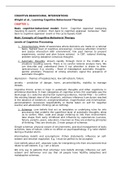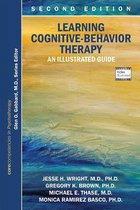COGNITIVE-BEHAVIOURAL INTERVENTIONS
Wright et al., Learning Cognitive Behavioural Therapy
CHAPTER 1:
Basic cognitive-behavioral model: Event Cognitive Appraisal (assigning
meaning to event) emotion then back to cognitive appraisal behaviour then
back to cognitive appraisal event or the cycle repeats itself.
Basic Concepts of Cognitive-Behavioral Therapy
Levels of Cognitive Processing:
1. Consciousness (state of awareness where decisions are made on a rational
basis, highest level of cognitive processing); conscious attention (monitor
and assess interaction with environment, link past memos to present
experiences, control and plan future actions) in CBT: rational thinking,
problem solving (adaptive conscious thought).
2. Automatic thoughts: stream rapidly through mind in the middle of a
situation/ recalling events. There is no careful rational analysis here. We
can describe and understand them if our attention is drawn to them
(preconscious). E.g. anxiety – flood of maladaptive automatic thoughts
painful emotions. Presence of strong emotions signal the presence of
automatic thoughts.
depression – themes of hopelessness, low self-esteem, failure.
anxiety – prediction of danger, harm, uncontrollability, inability to manage
threats.
Cognitive Errors: errors in logic in automatic thoughts and other cognitions in
emotional disorders. 6 main categories of cognitive errors (for examples see the
book page 11): selective abstraction (ignoring evidence, mental filter – to confirm
the existing biased view of the situation), arbitrary inference (conclusion reached
in the absence of evidence), overgeneralization, magnification and minimization,
personalization (excessive responsibility or blame taken on self for negative
events) and absolutistic thinking (all-or-nothing).
3. Schemas: core beliefs that act as templates or underlying rules for info
processing that underlie the superficial layer of automatic thoughts; allow
us to screen, filter, code and assign meaning to info from environment;
take shape from early childhood and influence by experiences (success,
failure, parents, peers, educators, traumas) so they are enduring principles
of thinking. They are shortcuts. 3 main groups of schemas:
Simple schemas: physical nature of environments, practical management of daily
activities, laws of nature. Little or no effect on psychopathology. E.g. take shelter
during a thunder storm.
Intermediary beliefs and assumptions: if-then statements; influence on self-
esteem and emotion regulation. E.g. I must be perfect to be accepted.
Core beliefs about self : absolute rules for interpreting info from environment that
relate to self-esteem. E.g. I am a failure.
We only say to patients that schemas/ core beliefs strongly influence our self-
esteem and behaviour and say that all people have healthy (adaptive) and
maladaptive schemas.
,Goal in CBT: identify and build up adaptive schemas, reduce or modify
maladaptive schemas.
CBT teaches thinking about our thinking to bring autonomous cognitions into
conscious awareness and control.
Maladaptive schemas may be dormant until a stressful event triggers/ activates
the core belief. Then the schema is strengthened to the point that it stimulates
ad drive the more superficial stream of negative automatic thoughts.
Info processing in depression and anxiety – key features of pathological
info-processing
Predominant pathological info-processing in depression hopelessness, low self-
esteem, negative view of environment, automatic thoughts with negative
themes, misattributions, overestimation of negative feedback, impaired
performance on cognitive tasks that require effort or abstract thinking (difficulty
in concentration, memory functioning).
Predominant pathological info-processing in anxiety fear of harm or danger,
increased attention to info on potential threats, overestimating risks in situations,
automatic thoughts associated with danger, risk, uncontrollability, incapacity,
underestimating the ability to cope with feared situations, misinterpreting the
bodily stimuli.
Common in both anxiety and depression increased automatic info-processing,
maladaptive schemas, increased frequency of cognitive errors, reduced cognitive
capacity for problem solving, increased attention to self, especially perceived
deficits or problems.
The link between hopelessness and suicide: high levels of hopelessness increases
the risk of suicide. In depression, the most important predictor of suicide is
hopelessness. Thus, a specific anti-suicide action plan is required to reduce the
risk.
Depressed individuals assign meaning (attributions) to event that are negative
distorted in 3 domains: internal vs. external (excessive self-blame for life events),
global vs. specific (pervasive effect on self-esteem and behavioral responses;
overgeneralizations), fixed vs. changeable (this won’t pass).
Distortions in response to feedback in depression: underestimation of the amount
of positive feedback and expending less effort on tasks after hearing negative
feedback.
Thinking style in anxiety disorders: increased attention to info from environment
about potential threats. A diminished estimate of ability to cope, a sense of
uncontrollability, high frequency of negative self-statements, misinterpretations
of bodily stimuli, overestimation of the risk of future calamities.
Overview of therapy methods
Key methods of CBT: problem-oriented focus, individualized case
conceptualization, collaborative-empirical therapeutic relationship, Socratic
questioning, using structuring, psychoeducation and rehearsal to enhance
learning, eliciting and modifying automatic thoughts, uncovering and challenging
schemas, behavioral methods to reverse patterns of helplessness, self-defeating
behaviours and avoidance, building CBT skills to prevent relapse.
, Therapy length: usually 45-50mins sessions, from 5-20 sessions depending on
the condition. Personality disorders, psychosis, bipolar disorder, chronic and
treatment-resistant conditions usually more sessions, sometimes more than 20.
Focus: mainly on “here and now”, but also past childhood experiences, social
influences, education and work history, family background, traumas, early
childhood development to fully understand the individual. Attention to current
issues – recent events are more accessible than past events.
Case Conceptualization: developing formulations that bring together the info
from diagnostic assessment, observations on unique background and cognitive
behavioural theory.
Therapeutic relationship: understanding, kindness, empathy. Generating trust. A
high degree of collaboration in CBT, action-oriented interventions and strong
empirical focus. The relationship is “collaborative empiricism” as Beck called it;
working like a scientific team with the client, developing hypotheses about
accuracy of coping value of variety of cognitions and behaviours. Then
collaborate on developing a healthier style of thinking, behaving, coping.
Openness, work-orientation, team-orientation, pragmatic approach in problem
management.
Socratic questioning: asking questions that stimulate curiosity and
inquisitiveness. An example: guided discovery – questions to reveal dysfunctional
thought patterns or behaviour.
Structuring and psychoeducation: agenda setting (gündem belirleme), feedback
to maximize efficiency of session, enhance learning. E.g. to agenda item: develop
a plan to get back to work. Using situations from patient life to illustrate concepts
is a method of psychoeducation in CBT. Patient is involved by answering
questions from therapist.
Cognitive restructuring: to identify automatic thoughts and schemas, learn skills
for changing cognitions and perform homework exercises. Socratic questioning,
thought records, examining evidence (pro-con analysis), reattribution (modifying
attributions), listing rational alternatives, cognitive rehearsal (role plays or
imagery).
Behavioral methods: to break patterns of avoidance or helplessness, to build
coping skills, to gradually face the feared situations and to reduce painful
emotions or autonomic arousal. Behavioral activation, hierarchical exposure
(systematic desensitization), graded task assignments, activity and pleasant
event scheduling, breathing and relaxation training.
Relapse prevention: teaching CBT skills to patient with repeated practice.
Discussing possible challenges after therapy is closed, coaching on ways to
respond to these challenges.
CHAPTER 2: Therapeutic Relationship
Collaborative Empiricism in Action
Action-oriented, straightforward and collaborative therapeutic relationship. Also,
a high degree of warmth, genuineness, positive regard and accurate empathy. In
CBT, it is a collaborative-empirical working alliance between therapist and client.
Substantial amount of clinical experience, case supervision and personal
introspection are required for maximizing skills in establishing a good therapeutic
relationship.






